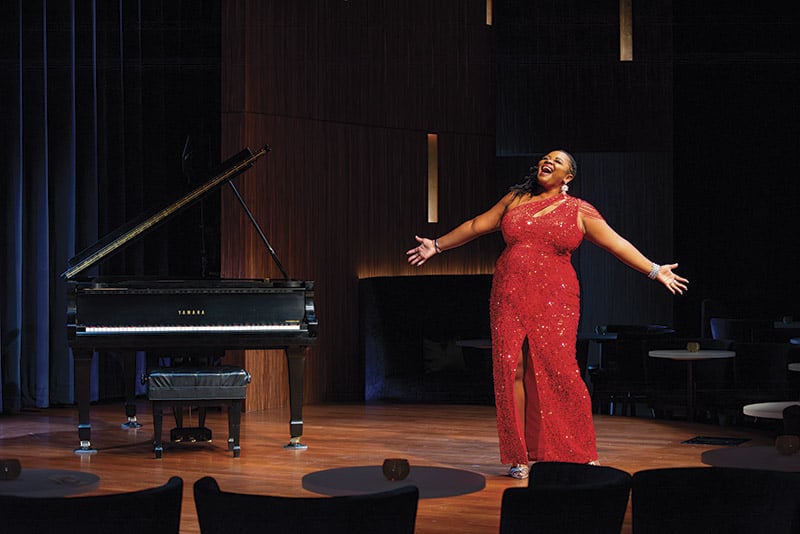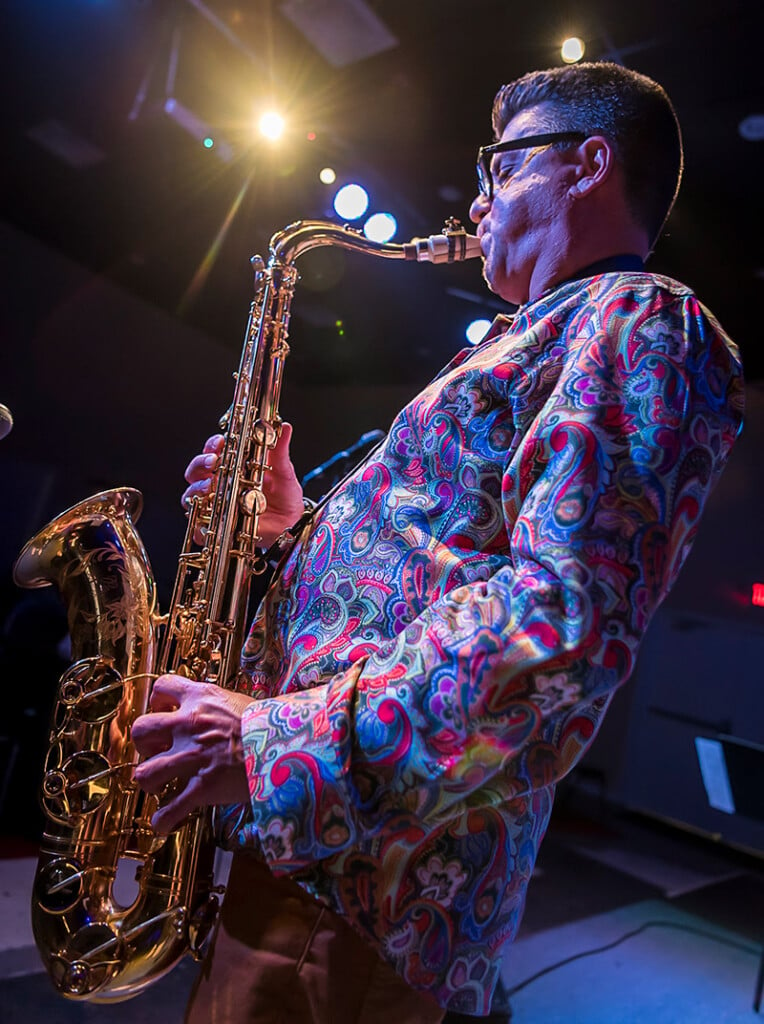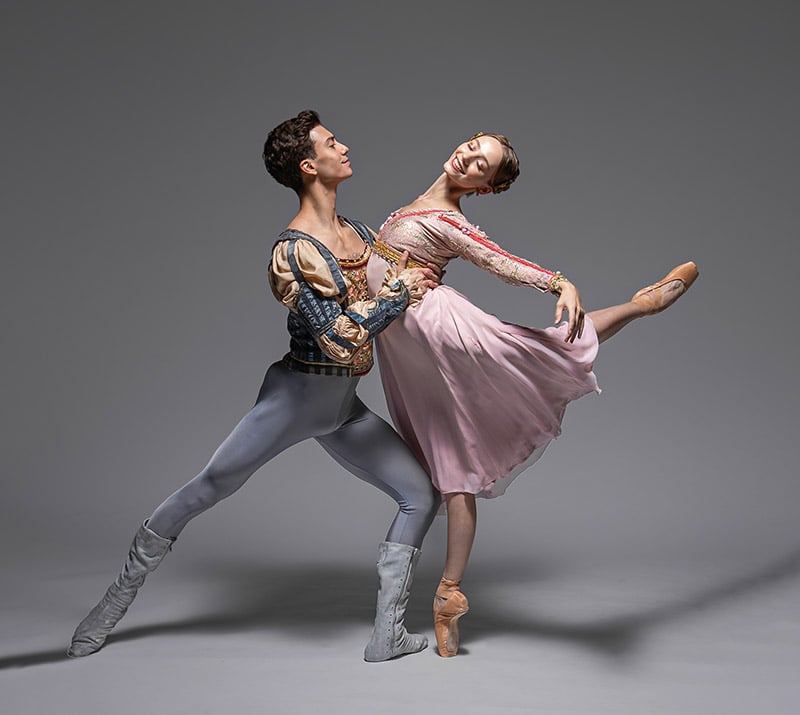Arts Season Preview: Events
Yes, we will have an arts season this year. And we’re here, as always, to share the highlights—from a phenom pianist to a talking plant.
The Russian Connection
Growing up in Beijing, Yuja Wang had a father who was a musician, and a mother who was a ballet dancer. Each tried to recruit her to their respective professions. Her father won, serving as taskmaster as she practiced her piano, while her mother gave her stretching exercises to increase the span of her fingers.
We should be grateful to both of them.
The 33-year-old phenom is one of the greatest concert pianists of her generation. She attracted early attention for her youth, her slight stature, and her sleekly revealing concert attire. A more compelling spectacle than the short dresses and high heels was the sight of an innately driven and athletically gifted talent storming her way through the canon of classical composers.
She was methodical about it, saving contemplative giants such as Brahms and Beethoven until she was ready, finding herself drawn first and forever to the thunderous passions of the Russian romantics.
She’ll bring that visceral kinship with her to Orlando to perform three Rachmaninoff piano concertos—the first, second and fourth.
It’s a program that would be out of technical reach to all but the elite. For her, says Wang, playing Rachmaninoff “is like reading a Russian novel with so many different characters and plots.”
She’ll appear in January as the Orlando Philharmonic Orchestra’s most noteworthy guest artist since cellist Yo-Yo Ma. The concert is slated to take place in the Dr. Phillips Center’s as-yet-unfinished $600 million-plus Steinmetz Hall, but will be moved to another venue if necessary.
Wang moved to the U. S. as a teenager to study with legendary classical pianist tutor Gary Graffman at the prestigious Curtis Institute of Music in Philadelphia. She now lives in Manhattan, where several years ago she struck up a friendship with fellow New Yorker Eric Jacobsen, Orlando Philharmonic Orchestra’s music director/conductor, and his wife, singer-songwriter Aoife O’Donovan.
Ask Jacobsen what distinguishes Wang as a performer, and he mentions technique. But he lingers on something else.
“Very few pianists would even attempt the program she’s doing here. It calls for over-the-top virtuosity,” he says. “But what’s truly amazing about Yuja is her sense of human relationships. It’s her empathy.”
Wang doesn’t just conquer compositions. She channels their composers. Someone once asked her to describe her affinity for the larger-than-life Russians.
“I have that blood,” she says.
Of that, there is no doubt.
A Cult-ivated Classic
In 1960, low-budget horror film producer Roger Corman took all of two and a half days of initial filming and stuck to a meager budget of $30,000 to crank out Little Shop of Horrors, a black-and-white sci-fi send-up about a people-eating plant from outer space that talks a nerdy flower-shop employee named Seymour into bringing folks around for dinner. Somehow, that part-goofy, part-creepy film—cinematically forgettable other than having featured a young Jack Nicholson in a bit part—took root as a perennial cult classic. First it inspired a campy, 1982 Off-Broadway rom-com musical with the plant at center stage, henpecking its dweeby host (“Feed me, Seymour!”) and growing larger from scene to scene to the tune of a Motown-infused score. A 1986 movie featuring Steve Martin and Jim Belushi was a cross-pollinated hit, while more recent stage and screen transplants include an upscale 2003 Broadway production, a 2019 Off-Broadway revival, and yet another movie version, still in the works, with producers trying to land Scarlett Johansson as Seymour’s love interest. Though it’s a favorite among community theaters, somehow the spring production of Little Shop marks the first time it’s taken root at Orlando Shakes. The timing couldn’t be better. If there’s one thing we need these days it’s a flat-out fun show like this one. Bring it on, Shakes, and let the sun shine in.
Pompeii and Circumstances
A funny thing happened on the way to Orlando for Pompeii: The Immortal City, a sprawling multimedia exhibit featuring relics and ruins from that fated Roman trade metropolis, buried and preserved in a layer of volcanic ash by the eruption of Mount Vesuvius almost 2,000 years ago. The exhibit, based on research and excavation by two Italian museums, was originally scheduled for display at the Orlando Science Center last summer, which would explain that wave of déjà vu that may have overtaken you just now. Planners had to postpone the exhibit’s Orlando visit to arrange an extended run at its previous stop, the Northwest Museum of Arts and Culture in Spokane, Wash., which had to temporarily close its doors in March because of COVID-19. The exhibit comes to the Science Center October 26, and features more than 100 objects; an immersive film re-creating the destruction; and two astonishingly-detailed molds of the volcano’s victims, made by pouring plaster in the hollows their bodies created in the dense, tightly-packed ash before disintegrating. The epic catastrophe is rendered with a slice-of-life approach: There is even a well-preserved, if slightly stale, loaf of bread. There also are family portraits, examples of the day’s street-artist graffiti and décor, and even ingenious medical instruments a Pompeii resident might have encountered on a visit to the doctor or dentist. To maintain a safe flow of visitors, admission will operate on a timed-entry, tickets-in-advance basis.
Risqué Ballet
Don’t expect to see the corps of the Orlando Ballet break out into a can-can during their production of Moulin Rouge – The Ballet this season.
Canadian choreographer Jorden Morris, who’s doing a stint as the ballet’s guest artist this season, was inspired to create the dance by the romantic allure of the famous fin de siècle Parisian cabaret, where French artist Toulouse-Lautrec hung out and showgirls made the then-scandalous high-kick skirt lift their signature.
But it’s ballet, if just a shade risqué, with Morris’ choreography making occasional frothy nods to the can-can. Its true inspiration is the overall cultural and artistic backdrop of La Belle Epoque Paris. Strains of Edith Piaf singing La Vie en Rose drift across the stage. One of the characters is even based on Toulouse-Lautrec.
The ballet, which focuses on a tragic romance between two characters caught up in the romantic revelry, has been performed across North America, Europe and Asia since its debut in 2009 by Canada’s Royal Winnipeg Ballet, where Morris was a principal dancer.
“The story came from the idea that I wanted to explore two young people of very different backgrounds thrown together in the cauldron of Paris at the time,” he says. “I wondered how these two characters would develop and ultimately succeed or fail in their attempt to be together.”
Morris also will premiere another work with the ballet this season, Peter Pan, and teach at the company’s summer intensives.
A Little Night Musical
The folks who bring the Broadway in Orlando series to the Dr. Phillips Center for the Performing Arts won’t miss 2020, a year that saw great shows such as To Kill a Mockingbird canceled or postponed because of the coronavirus. So it’s good that 2021 leads off with a fresh-start winner in The Band’s Visit, a touching road-trip tale, tentatively set for a January run, about an eight-man Egyptian band whose members miss the bus to their gig and wind up stranded overnight in a tiny Israeli town. Based on a sweetly comedic film of the same name, it features unique instrumentation, a boisterous and hypnotic score, and a series of compelling mini-moments over the course of a single night between the bemused small-town hosts and the visitors in their crisp periwinkle uniforms and caps. The Band’s Visit, which captured 10 of the 11 Tonys it was nominated for in 2018, might put you in mind of Come From Away, the musical about stranded Americans hosted by a small Newfoundland town where their planes were grounded by the 9-11 attacks. Like that show, The Band’s Visit appears on the surface to defy Broadway musical tradition. No intermission. No showstopper. But try to find a breathtaking song that captures the tried-and-true musical theme of living a small-town life with big-city dreams more surely than “Omar Sharif,” sung by the wistful owner of the town’s café as she muses about being carried away by the movies and television shows she watched as a child.

Pop Chalee (aka, Merina Lujan; American, 1906-1993), Untitled (Blue Horse). Collection of the Mennello Museum of American Art, Gift of Robert Melanson in memory of Frank Holt, Founding Director, 2018-005-009.
A Bittersweet Return
Frank Holt was never one for the spotlight, and he had a job that suited his temperament: staging exhibits, selecting artwork and quietly promoting local artists as Orlando’s public art director and executive director of the Mennello Museum of American Art.
Holt died four years ago at the age of 72, just a year after retiring. He’ll make a return, of sorts, to the museum he loved this spring, with an exhibit that will include his own extensive collection of prints and paintings by Southwestern artists.
He’d be pleased with the exhibit, says his husband and companion of 40 years and fellow collector, Robert Melanson. But as for any attention and honors that might go along with it, not so much.
“Oh, no. He’d never want that,” Melanson says. “Frank always preferred to stay in the background.”
Both men enjoyed collecting art, although their tastes couldn’t have been more different. While Holt was acquiring Southwestern art, Melanson, who served as director of the Winter Park Public Library for 26 years, focused on urban American modernists such as John Sloan, a painter and etcher who was one of the founders of the Ashcan School, a late 19th and early 20th century art movement that focused on capturing poverty-stricken New York City neighborhoods.
Holt’s collection included the works of two Native Americans, Harrison Begay and Pop Chalee, both of whom studied under crusading art educator Dorothy Dunn at the Santa Fe Indian School in the 1930s. Begay specialized in watercolors and silkscreen prints, while Chalee became known for her mystical horses and enchanted forests.
Art from both collections, parts of which have been donated permanently to the museum, will be featured in the spring exhibition. More than just an exhibit, it will represent yet another reunion of sorts.
“It will be bittersweet,” says Melanson.
In Brief
The title of the musical composition Terry Riley is best known for is only three letters long: In C.
How appropriate.
Riley is the 85-year-old “grandfather of American minimalism.” As a pianist-turned-composer in the 1960s, he began fusing his own wide-ranging influences, from jazz pioneer John Coltrane to Indian classical voice legend Pandit Pran Nath, with repetitive studio techniques such as overdubbing and delay systems.
Riley developed his method further in a 1969 album, A Rainbow in Curved Air, which had a profound influence on several American and European recording artists. He was a huge inspiration for musicians ranging from Philip Glass to British composer-songwriter Mike Oldfield to rock groups such as The Who.
In a collaboration between the Timucua Arts Foundation and Orlando jazz and improv troupe Civic Minded 5, Riley will do a stint as “artist in resonance” at the “White House,” home of Timucua founders Benoit and Elaine Glazer.
That’s appropriate, too. Originated by the Glazers as a home-concert series and later under the guidance of Executive Director Chris Belt, Timucua has evolved into an efficiently minimalist nonprofit in its own right. Its wide-ranging concert series, with some events free and some ticketed, is still staged in the Glazer’s home—and the artists who take the stage are compensated with donations from the crowd and with a professionally-recorded tape of their performance.

Courtesy of the Orange County Regional History Center. Staff have used the invaluable resources of the History Center’s Collection, the Special Collections & University Archives at the University of Central Florida Libraries, the George A. Smathers Library at the University of Florida, the Orlando Sentinel, and more.
Massacre Remembered
Twenty years ago, I interviewed a thin, bespectacled man of 93 named Armstrong Hightower. He lived in a two-room apartment in Fort Lauderdale and was, as far as I could tell, the last remaining survivor of an infamous massacre and race riot in the West Orange town of Ocoee on Election Day 1920. One Black man was lynched. Scores of Black residents were murdered. Any who survived fled their community, never to return.
That included Hightower, who could remember, as a boy of 12, fleeing into an orange grove to hide and seeing a neighbor’s barn burst into flame. At the end of the interview, he asked me a question—one that swept away the decades and gave me a sense of just how indelible such a horrific memory could be.
He wondered: “Are there any Black folks living up there now, in Ocoee?” He admitted he was still afraid to return.
The Ocoee race riot will be explored in a landmark exhibit marking the 100-year remembrance of the massacre at the Orange County Regional History Center in October.
Apart from examining the white-on-Black, KKK-inspired attack itself, which was triggered when a Black man named Mose Norman tried to vote and was turned away, the exhibit “will explore not only this horrific time in our community’s history, but also historical and recent incidents of racism, hatred and terror, some right here at home,” according to a History Center release. The hope is that the exhibit will “encourage reflection on a century of social transformation, the power of perspective and the importance of exercising the right to vote.”
As for Armstrong Hightower, I was happy to discover he made his peace with the terrible memory he lived with for decades. A year after I interviewed him, he was able to visit Ocoee with another reporter. He died that same year.
Home for a Hearth
Louis Comfort Tiffany wanted to turn everything into art, not just the stained glass windows and lamps that brought him fame. In the lush, fantastical decors he created, even something as humble as a fireplace hood—a rectangular metal shield suspended over a hearth to keep embers at bay—could become a magical element.
One such hood designed by Tiffany—the only one in existence—was a sinuous wrought-iron affair adorned with translucent cutouts and Japanese sword guard symbols. It made the firelight dance in his family’s 57-room mansion at the corner of 72nd Street and Madison Avenue in New York City, built in the late 1800s—and Tiffany liked it enough to move it to Laurelton Hall, the Long Island summer home he built in 1905.
The hood disappeared when Laurelton Hall fell into disrepair in the 1950s, but resurfaced earlier this year when a private collector consigned it to Lillian Nassau, a New York City antiques dealer. It was acquired by the Charles Hosmer Morse Museum of American Art in Winter Park, which houses the world’s most comprehensive collection of Tiffany’s work.
The 66-inch by 55-inch hood will be installed in a hallway leading to the museum’s magnificent collection of Laurelton Hall furnishings and architectural elements as a creation that typifies Tiffany’s expansive, all-encompassing decorative passion. Says Morse Curator Jennifer Thalheimer, “You have this practical necessity: a fireplace to keep you warm. But for Tiffany, it’s an excuse to create art.”
Lost and Found
By today’s standards, Clarence Bloomfield Moore was a terrible archaeologist. He had no formal training, referred to himself as a “gentleman scholar” and retired from a successful family business in the late 1800s. He chose to travel throughout the world in search of antiquities—including destructive forays throughout the United States—in a steamship he called “Gopher,” to indiscriminately root through Native American shell middens, mounds and even graves.
Moore will figure in a unique faculty and student-driven exhibition at Rollins College’s Cornell Fine Arts Museum, highlighting some of the finds of amateur collectors that wound up, forgotten, in the museum’s storage vaults.
The genesis of Storied Objects: Relics and Tales from the Thomas R. Baker Museum goes back to 1909, when a fire destroyed the original Rollins Museum and the college sent out a nationwide plea for individuals and institutions to contribute natural specimens and cultural artifacts for a new museum, named after a beloved Rollins science professor.
Thousands of objects flooded into Rollins—fossils, an ancient Roman sword, a collection of Sumerian cuneiforms, all finding a home in the new museum, which prospered for decades but eventually fell into disuse and was shuttered in the 1970s. What was left of its treasures was stored and forgotten—until now.
The fall exhibit, which opens Sept. 14 and runs through January, highlights both the objects themselves and their colorful contributors. It’s a collaboration between the museum staff; Zackary Gilmore, assistant professor of anthropology at Rollins College; Robert Vander Poppen, associate professor of classical art and archaeology; and students from their classes.
Boundless Inspiration
There’s a lovely sentence near the end of The Prophet, Kahlil Gibran’s poem about an exile’s journey of discovery: “Only another winding will this stream make, only another murmur in this glade, and then shall I come to you, a boundless drop to a boundless ocean.”
That last phrase seemed a perfect title to Orlando Museum of Art Curator Coralie Claeysen-Gleyzon and her co-curator, Dr. Shiva Balaghi, at the American University in Cairo, for a joint exhibition featuring paintings, drawings, sculptures and photographs by 22 leading Iranian-American and Arab-American artists that will open at OMA in January.
A Boundless Drop to a Boundless Ocean was inspired by a photograph by Iranian filmmaker and photographer Shirin Neshat that was recently added to OMA’s collection. Neshat left Iran as a teenager and developed a career in the United States that included her images starkly illustrating the muting and systemic cultural repression of women, often by superimposing calligraphy over their faces.
“These artists have made an incredible contribution to the landscape of American art,” says Claeysen-Gleyzon. “The migrant journey is paved with loss and grief and hardship, but the artistic freedom that they found in this country makes much of their work poetic and vibrant.”
She hopes the exhibit will capture the duality and pathos at the heart of diasporic communities—the bitter gift inherent in leaving behind a homeland, but finding yourself in a country that gives you the freedom to express your love for it.
Togetherness—From a Distance
For the first time in her brainchild’s 18-year run, the founder of Orlando’s Global Peace Film Festival will not be here to orchestrate programs that explore and celebrate the pursuit of peace—politically, culturally, spiritually and, most of all, individually.
No man is an island. But Nina Streich is stranded on one. “I haven’t left Manhattan since March,” she says.
This year, Streich will be overseeing the festival from her apartment on the Upper West Side for two reasons. One: Because of COVID-19, if she were to fly from New York City to Orlando, she’d have to spend two weeks in self-enforced quarantine at both ends of the trip. Two: For the same reason, the festival will take place mainly online.
“People will go to our website. They’ll be able to see information and trailers about the films we are featuring, which will be available for different time periods throughout the festival,” she explains. Virtual interviews with the filmmakers also will be offered online. Films will be available for purchase individually and as packages.
The two-week festival kicks off on the International Day of Peace, Sept. 21, with a screening of The Third Harmony (shown above), a documentary that explores the practical applications of nonviolence.
“We’re flying blind,” says Streich of the festival’s virtual debut. But she’s discovered some advantages. For example, many of the filmmakers and subjects are from overseas (hence the eponymous “global”), and she’s hoping to arrange for them to appear online to discuss their films, both before and after screenings.
A Creole Carmen
Usually the characters in an opera are the only ones who die a tragic death. Not so for Carmen, whose composer, Georges Bizet, became ill a few days after his tale of a defiant gypsy temptress premiered in Paris in 1875. He went to his grave thinking it was a flop instead of living long enough to realize he’d written one of the most popular operas in history.
Carmen has been revived and reinvented into everything from a hip-hop version to a reincarnation on ice. For Opera Orlando’s March production, which will be presented at the Disney Theater at the Dr. Phillips Center, Executive Director Gabriel Preisser looked for an inventive approach of his own and found it close at hand.
The opera will be set in Haiti during the repressive mid-century reign of dictator Francois “Papa Doc” Duvalier. “We’re always engaged in outreach, trying to stay in touch with all of the city’s diverse communities,” says Preisser. “And we discovered that Creole is the third-most spoken language in Orlando.”
Preisser dug deeper in his discussions with members of Creole churches and community leaders, including Orange County Commissioner Victoria Siplin, who also serves as chairwoman of the National Haitian American Elected Officials Network. Soon, he realized the setting and the time period made a perfect backdrop for the struggles of his stormy heroine.
“The more we looked into Haitian history, the more we liked the idea,” he says. “You can see the dynamic between the desperate scenario of that time, and a person like Carmen, who’ll do whatever it takes to survive.”














